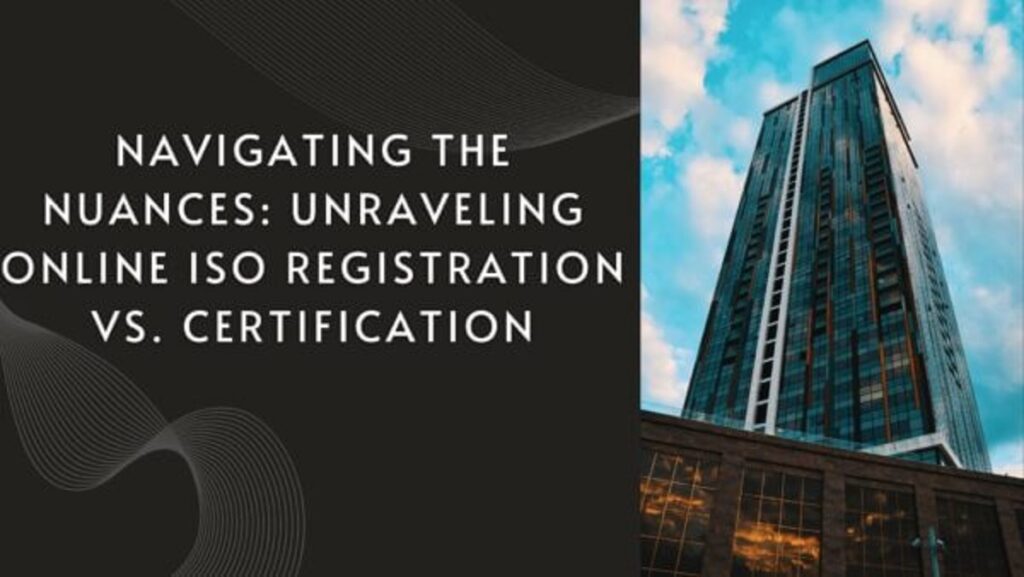
In today’s global marketplace, businesses strive to demonstrate their commitment to quality, efficiency, and compliance by adhering to international standards. Among these, the International Organization for Standardization (ISO) offers a framework that helps organizations maintain consistency and meet regulatory requirements in various industries. Yet, navigating the intricacies between ISO registration and certification remains a perplexing challenge for many enterprises.
Note: You Can Apply for ISO 9001 Certification
Understanding the fundamental differences between ISO registration and certification is crucial for companies aiming to establish their credibility, improve processes, and gain a competitive edge. This comprehensive guide aims to shed light on the distinctions, significance, and implications of online ISO registration versus certification.
Overview of ISO Registration and Certification
ISO Registration:
ISO registration involves the initial step of formally documenting an organization’s intent to comply with specific ISO standards. It typically comprises the establishment of an ISO management system and the submission of documentation outlining how the company intends to meet the standard’s requirements.
During this phase, an organization engages in self-assessment and aligns its processes, policies, and procedures with the relevant ISO standards. It doesn’t involve an external assessment or validation by an independent certification body. Instead, registration demonstrates the company’s commitment to implementing the standard’s principles.
ISO Certification:
On the other hand, ISO certification, also known as ISO accreditation, refers to the formal evaluation of an organization’s compliance with ISO standards by an accredited third-party certification body. This process includes comprehensive audits, reviews, and assessments to ensure the company’s adherence to the specified ISO criteria.
Obtaining ISO certification requires a rigorous examination of the organization’s operations, processes, and systems to verify their alignment with the standard’s requirements. Upon successful evaluation, the certification body issues a formal certificate attesting that the company complies with the relevant ISO standard.
Key Differences between ISO Registration and Certification:
Validation Process:
Registration involves self-declaration and does not entail external validation by an independent body.
Certification necessitates thorough audits and assessments by accredited certification bodies to verify compliance.
Credibility and Recognition:
Registration signifies a commitment to implementing ISO standards but may not hold the same level of credibility as certification.
Certification demonstrates that an organization’s processes meet the stringent requirements of the ISO standard, enhancing credibility and market recognition.
Scope of Evaluation:
Registration primarily focuses on documenting an organization’s commitment to implementing the standard’s principles.
Certification involves a comprehensive assessment of the organization’s operations, processes, and systems against the ISO standards’ criteria.
Use of Certificates:
Registered companies may use the term “ISO Registered” or display a “Tick Mark” to indicate their commitment to the standard.
Certified organizations are entitled to use the specific ISO standard number on their certificates, demonstrating compliance with international standards.
Significance and Implications:
Market Competitiveness:
Certification can provide a competitive advantage by enhancing an organization’s reputation and marketability, especially when dealing with international clients and tenders that require ISO compliance.
Risk Mitigation:
Certification mitigates risks by ensuring adherence to best practices, enhancing operational efficiency, and reducing errors or inconsistencies in processes.
Continuous Improvement:
Both registration and certification encourage continual improvement, fostering a culture of excellence within an organization.
Online ISO Registration vs. Certification:
The advent of online platforms has revolutionized the accessibility and ease of obtaining ISO registration or certification. Online ISO registration typically involves self-assessment tools, documentation guidance, and submission processes facilitated through web-based interfaces. However, it’s important to note that certification still requires rigorous on-site audits conducted by accredited certification bodies, although the initial application and documentation processes might be handled online.
Conclusion:
In essence, while ISO registration demonstrates an organization’s commitment to implementing international standards, ISO certification validates compliance through rigorous evaluation by independent certification bodies. Both play pivotal roles in enhancing credibility, improving processes, and fostering competitiveness. Businesses must carefully assess their objectives, resources, and market requirements to make informed decisions regarding whether to pursue registration, certification, or both.
Navigating the nuances between online ISO registration and certification empowers organizations to chart a path towards operational excellence, regulatory compliance, and sustained success in a dynamic global landscape.
Remember, whether opting for registration or certification, the commitment to adhering to ISO standards signifies a dedication to quality, efficiency, and continual improvement – essential elements in today’s ever-evolving business environment.





